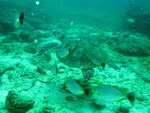Pulau Payar and its adjacent islands are some of the few locations for good diving off the West Coastof Peninsular Malaysia .Divers flock here during the monsoon season in the East Cost ,making Payar but one example of Malaysia’s year-round diving destinations. Large number of coral species lie embedded here ,both hard and soft.Their colour and variety provide good opportunities for photography ,comparable to some East Coast destinations .

A large ,permanent pontoon offshore is a great stopover for its many amenities is a great stopover for its many amenities and the panoramic view.From here ,traveling to the dive sites is a matter of minutes .At Coral Garden ,you will be enthralled by the colourful soft corals and many reef fish varieties .Next to it is Grouper Farm ,a site renowned for its many groupers,snappers and even barracudas .



Futher out to the west ,limited wall-diving opportunities also exist around to tiny Pulau Segantang .Reef life here range from the many anemones at Anemone Garden to the snappers ,jacks ,and barracudas at Tyre Reef .
How to getting there ? You can buy ticket at Kuah Jetty counter .Many packaged there and many agent .



Day trips are the only way of discovering Payar,although limited accommodation not available here .However ,nearby Langkawi ,the main island ,makes an ideal launch pad .Journeys take from 45 minutes to an hour,depending on the sea conditions.With Langkawi’s duty-free status and multitude of activities ,there will be plenty to see and do to spice up your holiday .



Climate and Water Temperature
Malaysia has an equatorial climate with fairly uniform temperatures ranging from 32°C during the day to 22°C at night .Humidity is about 85 to 95 per cent . Water temperature is 27 - 28°C and during the dry months the temperature may rise to 30 - 31°C . Divers will not require thick wet suits . A wet suit of between 1.5 to 3 millimetres is appropriate .
Best times to Dive
West Coast of Peninsular Malaysia – December – May
East Coast of Peninsular Malaysia – March – October
The island around Sabah and Sarawak are reasonably well protected and can be dived all year round . However ,water visibility is better during the months of April to August .





